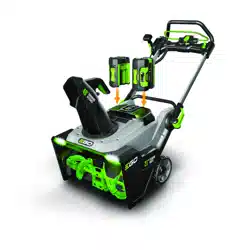Documents: Go to download!
- User Manual - (English, French, Spanish)
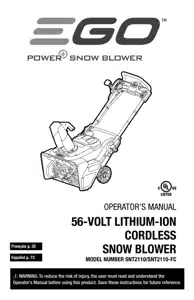
- DESCRIPTION
- ASSEMBLY
- OPERATION
- MAINTENANCE
- TROUBLESHOOTING
Table of contents
User manual Snow Blower
DESCRIPTION

WARNING: The safe use of this product requires an understanding of the information on the tool and in this operator’s manual, as well as knowledge of the project you are attempting. Before use of this product, familiarize yourself with all operating features and safety rules.
Safety Button
The safety button must be pressed down before the motor can be started.
Bail Switch
The bail switch is located on the upper handle of the snow blower. The switch engages and disengages the motor and auger.
WARNING: The bail switch and the safety button are safety devices. Never attempt to bypass their operations.
Electric Brake
Quickly stops auger rotation when the bail switch is released.
Quick-Release Lever
Locks/unlocks the side rails for working or storage positions.
Variable-Auger-Speed Adjustment
Adjusts the auger speed in order to adjust the throwing distance.
Chute-Rotation Handle
Rotates the chute so that the user may direct the discharged snow as desired. The handle allows the chute to rotate left 90° to right 90°.
Chute-Deflector Handle
Adjusts the angle of the chute and the height of the discharge stream.
LED Headlights
The LED headlights are located on the front of the unit. This feature provides extra light for increased visibility
ASSEMBLY
UNFOLDING/FOLDING THE SIDE RAILS
WARNING: Do not attempt to start the snow blower when the side rails are folded down.
To unfold the side rails
- Your snow blower is shipped with the side rails in the compact, locked position (Fig. 2).
- Open the quick-release levers on both sides and gently pivot the side rails upwards until they come to a stop (Fig. 3 & 4).
- Close the quick-release levers and then tighten the knobs to secure the side rails in place (Fig. 5).


To fold the side rails
1. Push the chute-rotation handle all the way forward so that the chute is facing left as you stand behind the snow blower. Squeeze the trigger on the chute deflector handle to tilt it all the way down (Fig. 6).
2. Open the quick-release levers on both sides to fold the side rails into the storage position (Fig. 7).

INSTALLING THE CHUTE
1. Use the supplied hex wrench to loosen the two bolts in the chute housing and remove them (Fig. 8).
2. Align the grooves of the chute with the slot on the chute housing, and then push the chute into place (Fig. 9).
3. Use the hex wrench to lock the chute in place with the two bolts (Fig. 10).
WARNING: Using the chuterotation handle located at the operator’s position, make sure that the chute rotates properly with the discharge opening never crossing operator controls.
WARNING: Never operate the snow blower without the complete discharge chute in place.

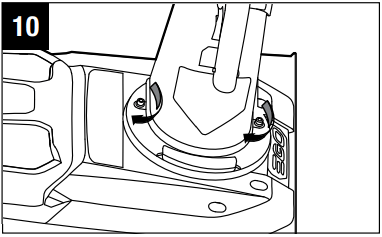
OPERATION
WARNING: Do not allow familiarity with this product to make you careless. Remember that a careless fraction of a second is sufficient to inflict serious injury.
WARNING: Always wear eye protection with side shields marked to comply with ANSI Z87.1. Failure to do so could result in objects being thrown into your eyes and other possible serious injuries.
WARNING: Do not use any attachments or accessories not recommended by the manufacturer of this product. The use of attachments or accessories not recommended can result in serious personal injury
APPLICATION
You may use this product for purpose listed below:
Removing snow from areas such as driveways and sidewalks.
TO ATTACH/DETACH THE BATTERY PACK
CHARGE BEFORE FIRST USE.
NOTE: For best performance, we recommend use with two 5.0Ah EGO 56V ArcLithium batteries or with two EGO 56V Arc-Lithium batteries of greater capacity.
When not in use, 56V battery packs should be stored in an enclosed area where the temperature will not drop below -4°F (-20°C). Optimal charging temperatures are between 41°F (5°C) and 104°F (40°C).
WARNING: If any parts are broken or missing, do not attempt to attach the battery packs to the snow blower or operate the snow blower until the broken or missing parts are replaced. Failure to do so could result in serious injury.
1. The battery cover is hinged. Raise the battery cover by lifting the front of the cover.
2. The snow blower is equipped with two battery compartments, which accommodate two battery packs at the same time.
3. Align the grooves in the battery pack with the raised ribs in one of the battery compartments, and then insert the battery pack into the compartment (Fig. 11).
4. Push the battery pack until you hear a “click”. The battery-release button will spring up when the battery pack is securely attached.
5. Attach the other battery pack into the other battery compartment in the same way.
6. To detach the battery pack, depress the battery-release button to release the battery pack, and then lift it out of the compartment (Fig. 12).
7. Close the battery cover.
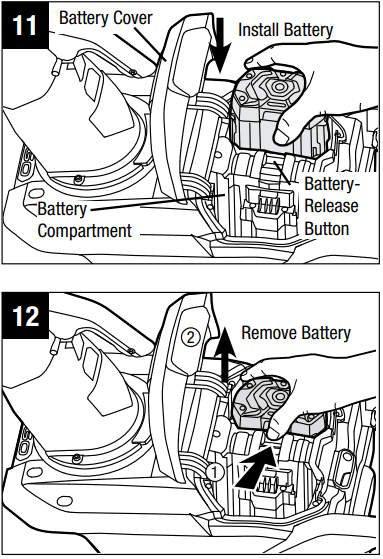
NOTICE: Make sure that the latch on the snow blower snaps into place and that the battery pack(s) are secured to the unit before starting operation.
STARTING/STOPPING THE SNOW BLOWER
CAUTION: Do not attempt to override the operation of the safety button and bail switch.
WARNING: The operation of a snow blower can result in foreign objects being thrown into your or others’ eyes, which can damage eyes severely. Always wear safety glasses while operating the snow blower or while performing any adjustments or repairs on the snow blower.
WARNING: Ensure that other people and pets remain at least 100’ (30m) away from the snow blower when it is in use.
WARNING: The auger will continue to rotate for a few seconds after the snow blower is turned off. Allow the auger to stop rotating before starting it again.
NOTICE: Do not rapidly turn the snow blower off and on.
To Start the Snow Blower
1. Ensure that the side rails are securely locked in the unfolded, open position.
2. Attach the battery pack(s) to the snow blower and close the battery cover.
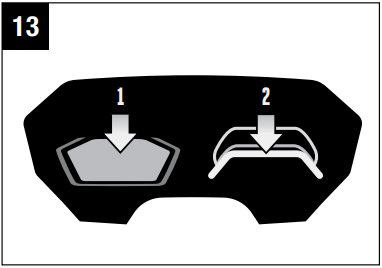
NOTICE: Make sure that the latch on the snow blower snaps into place and that the battery pack(s) are secured to the snow blower before operation.
3. Depress the safety button and, with the button depressed, pull the bail switch upward to meet the handle (Fig. 13 &14).
4. Once the tool powers on, release the safety button and begin operation (Fig. 15).
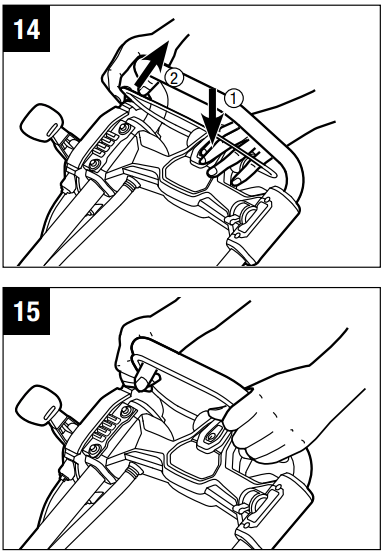
NOTICE: The tool is started by depressing the safety button first, followed by squeezing the bail switch; the reverse operation will not start the tool.
NOTICE: The snow blower may not properly start if its battery temperature is -4°F (-20°C) or less. If unit doesn’t start, remove the battery from the snow blower and allow it to warm indoors for 10 minutes or longer. Reinstall the battery and try again.
To Stop the Snow Blower
1. Fully release the bail switch (Fig. 16).
2. The electric brake in the Automatic Braking Mechanism will stop the auger rotation within 3 seconds of the bail-switch release.

Variable-Auger-Speed System (Fig. 17)
The speed of the auger can be adjusted to control the throwing distance.
1. To increase the speed, move the variable-auger-speed adjustment forwards.
2. To decrease the speed, move the variable-auger-speed adjustment backwards.
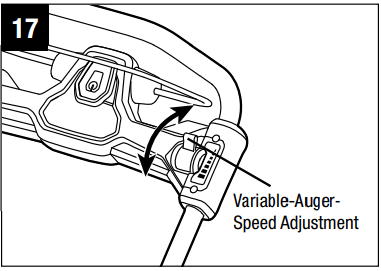
ADJUSTING THE CHUTE
The chute can be adjusted to change both the direction and the distance of the discharged snow to assist you in moving snow away from one area and placing it in another.
The direction of snow removal can be adjusted up to 180° (Fig. 18).
1. Push the chute-rotation handle forward to rotate the chute to the left.
2. Pull the chute-rotation handle backward to rotate the chute to the right.
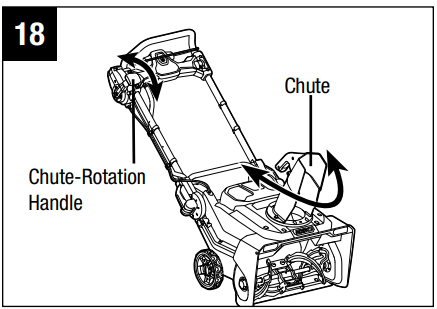
The throwing distance of the snow blower is adjusted by moving the chute deflector up or down (Fig. 19). Release the bail switch before adjusting the chute deflector.
1. To increase the distance that the snow is thrown, squeeze the trigger on the chute-deflector handle, and then raise the chute deflector. Release the trigger on the chutedeflector handle to lock the chute deflector in place (Fig.19).
2. To decrease the distance that the snow is thrown, simply lower the deflector with the chute-deflector handle.

WARNING: Do not force the chute so far forward that a gap appears between the deflector and the chute itself. Snow or other debris could be thrown through the gap and back at the operator, resulting in serious personal injury.
WARNING: Do not adjust the chute deflector while the bail switch is engaged.
Always release the bail switch before adjusting the chute deflector.
CLEARING A CLOGGING CHUTE
WARNING: Hands coming in contact with the rotating auger inside the chute is the most common cause of injury associated with snow blowers. Never use your hand to clean out the chute.
To Clear the Chute:
- Shut the motor and auger off!
- Remove the battery pack(s) from the snow blower.
- Wait 10 seconds to be sure the auger has stopped rotating.
- Always use a clean-out tool, such as a wood rod or other clearing tools that are commercially available; do not use your hand.
LED HEADLIGHTS (Fig. 20)
The LED headlights are located on the front of the snow blower.
- To turn on the lights, press the LED button (Fig. 21 & 22). The headlights provide bright light in front of the snow blower.
- To turn off the headlights, press the LED button again.
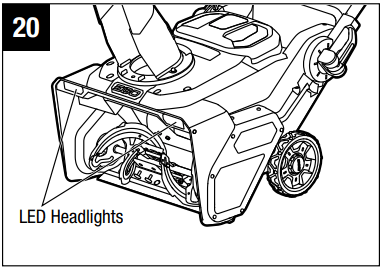
POWER INDICATOR ON THE SNOW BLOWER (Fig. 21 & 22)
The snow blower is equipped with a power indicator to indicate the charge level of the battery pack(s) and the working status of the snow blower. The power indicator will illuminate when the auger is rotating or when the LED headlights are turned on.
- The green light indicates that the battery pack(s) is over 15% of its charge capacity.
- The red light indicates that the battery pack’s charge is low.
- The blinking red light indicates that the battery pack is nearly depleted and needs to be charged immediately
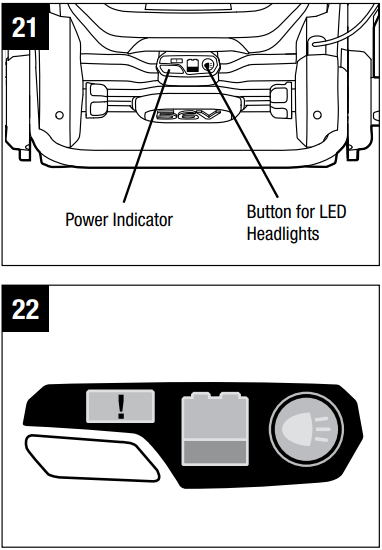
| POWER INDICATOR | MEANING | ACTION |
| Shining green | Snow blower is working properly; each battery has at least 15% of its charge. | n/a |
| Shining red | Battery pack(s) charge level is low. | Stop the snow blower and charge the battery pack(s). |
| Flashing red | The battery pack is nearly depleted. | Stop the snow blower and charge the battery pack(s). |
| Shining orange | The snow blower or a battery pack is overheated. | Stop the snow blower and wait for some time to cool the machine or the battery pack(s). |
| Flashing orange | The snow blower is overloaded. | Remove the battery pack(s), check and clean if snow has collected beneath the deck or is lodged in the auger. Slow down your pace or decrease the snow clearing cut width when working. |
SNOW BLOWER OVERLOAD PROTECTION
To prevent overload conditions, do not try to remove too much snow at one time. Slow down your pace or decrease the width of the snow-clearing swath.
Your snow blower has built-in overload-sensing elements. When the snow blower is overloaded, the motor will decrease the speed automatically and you will hear the volume of the motor decrease. Slow down your pace or narrow the clearing width in this case, after which the motor speed will resume its normal setting automatically. If this remedy does not solve the overload situation, the sensor will shut off the motor automatically and the power indicator will blink orange. Remove the battery pack(s) from the snow blower. Check to see if there is snow or ice stuck in the auger and deck, and use a clean-out tool to clear them out as necessary. Reinstall the batteries and restart the snow blower.
BATTERY HIGH-TEMPERATURE PROTECTION
If the battery temperature exceeds 158°F (70°C) during operation, the temperature protection circuit will immediately shut off the snow blower to protect the battery packs from overheating damage. The power indicator on the snow blower will shine orange and the LED on the battery will flash orange or shine red.
NOTICE: The LED on following battery packs will flash orange lights when overheated: BA1120, BA1120-FC, BA1400, BA1400-FC, BA2240, BA2240-FC, BA2800, BA2800-FC, BA4200 and BA4200-FC; the LEDs on following battery packs will shine red lights when overheated: BA1400T, BA1400T-FC, BA2800T, BA2800T-FC, BA4200T, BA4200T-FC, BA5600T and BA5600T-FC.
Release the bail switch and wait until the overheated battery pack(s) cool down and the flashing orange light on the battery LED turns green, then restart the snow blower.
To prevent shut off due to battery high-temperature protection, don’t try to use a single battery to power the snow blower when the depth of the accumulated snow exceeds 3 inches or when the snow is very wet or icy.
We recommend the use of two batteries working simultaneously. This is helpful in attaining the peak power of the snow blower.
After high-temperature protection has occurred, slow down your pace and narrow width of the clearing swath to reduce the load on the battery.
OPERATING TIPS
DANGER: Never use a snow blower on frozen lakes, rivers, or similar surfaces. Death or serious injury could occur if the ice breaks.
DANGER: Never use the snow blower on a rooftop or other unstable surface, which can result in death or serious personal injury.
WARNING: Do not use snow blower on ice, which can cause the operator to slip and fall, resulting in possibly serious personal injury.
WARNING: Do not wear loose clothing, scarves, or jewelry. They can be caught in moving parts and cause death or serious personal injury.
WARNING: Keep all snow discharge pointed away from all electrical devices to reduce the risk of electrocution or electric shock.
WARNING: Never point the snow blower or discharge chute in the direction of people or pets. Thrown snow or other objects can cause serious personal injuries.
WARNING: Make sure that the area to be cleared is free of stones, sticks, wires, gravel, and other objects that could be accidentally thrown by the snow blower in any direction and cause serious personal injury to the operator and others.
- If the unit comes in contact with any type of obstruction or debris during use, stop the snow blower, remove the battery pack(s), remove the obstruction, and inspect the unit carefully for damage before proceeding.
WARNING: Never reach into the discharge chute or place any body part in front of the snow blower when the unit is operating or when the battery pack(s) are installed. Always ensure all moving parts have stopped and the battery pack(s) have been removed before clearing any obstructions. Failure to follow these instructions can result in serious personal injury.
- Take notice of the direction of the wind before beginning. When possible, discharge snow in the same direction as the wind to prevent snow from being thrown back into your face.
- Some parts of the snow blower can freeze under extreme weather conditions. Do not attempt to operate the unit with frozen parts.
- When finished, allow the motor to run for an additional few minutes to prevent moving parts from freezing, then turn the chute rotation handle back and forth several times to free it from any ice buildup. Make sure to clean off any snow and ice from the base of the chute.
- In snowy and cold conditions, some controls and moving parts may freeze. Do not use excessive force when trying to operate frozen controls. If you have difficulty operating any control or part, start the machine as “STARTING/STOPING THE SNOW BLOWER” section shown and let it run for a few minutes.
MAINTENANCE
WARNING: To avoid serious personal injury, always remove the battery pack(s) from the snow blower before cleaning or performing any maintenance.
WARNING: When servicing, use only identical replacement parts. Use of any other parts may create a hazard or cause product damage. To ensure safety and reliability, all repairs should be performed by a qualified service technician.
NOTICE: Periodically inspect the entire product for damaged, missing, or loose parts such as screws, nuts, bolts, caps, etc. Tighten securely all fasteners and caps and do not operate this product until all missing or damaged parts are replaced.
GENERAL MAINTENANCE
Avoid using solvents when cleaning plastic parts. Most plastics are susceptible to damage from various types of commercial solvents and may be damaged by their use.
Use clean cloths to remove dirt, dust, oil, grease, etc.
WARNING: Do not at any time let brake fluids, gasoline, petroleum-based products, penetrating oils, etc. come in contact with plastic parts. Chemicals can damage, weaken, or destroy plastic which can result in serious personal injury.
LUBRICATING THE MACHINE
All of the bearings in this product are lubricated with a sufficient amount of high grade lubricant for the life of the unit under normal operating conditions. Therefore, no further bearing lubrication is required.
REPLACING THE SCRAPER BAR
WARNING: Make sure to turn off the bail switch and remove the battery pack(s) before performing any maintenance task on your snow blower.
1. The scraper bar is located at the bottom of the snow blower beneath the auger (Fig. 23).
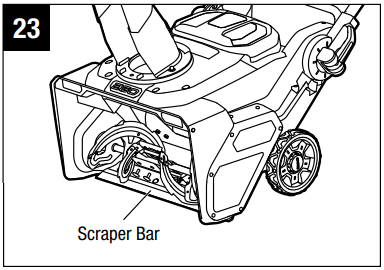
2. Turn the snow blower on its side (Fig. 24).
3. To reduce the risk of injury, wear gloves. Use a socket wrench (not included) to remove the 5 nuts (Fig. 24). Detach the worn scraper bar from the snow blower.

4. Attach the new scraper bar to the snow blower with the shiny surface facing the inside of the deck. Align the mounting holes in the scraper bar with the holes in the steel deck. Insert the 5 bolts into the mounting holes from the inside, shiny surface of the scraper bar (Fig. 25a).
5. Place the spring washers and nuts on the bolts (from the outside of the deck) and use a socket wrench (not included) to securely fasten the scraper bar to the deck (Fig. 25b).
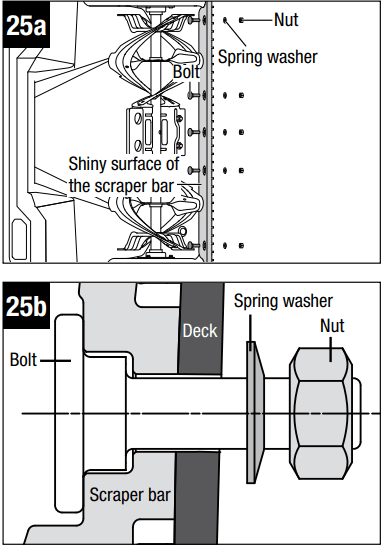
REPLACING THE RUBBER PADDLE
WARNING: Make sure to turn off the bail switch and remove the battery pack(s) before performing any maintenance task on your snow blower.
- Wear gloves. Manually rotate the steel auger to the appropriate position for easy rubber paddle disassembly as Fig. 26 shown.
- Use a flat head screwdriver(not included) to thoroughly loosen the two bolts on one side and remove the two bolts and two nuts to take away the rubber paddle from the steel auger.
- Disassemble the other rubber paddle on the other side in the same way.
- Replace them with the new rubber paddles and securely tighten them.
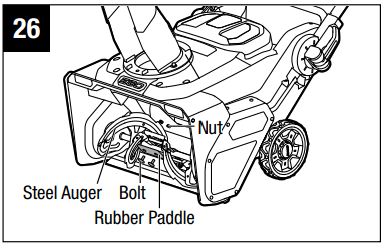
REPLACING THE DRIVE BELT
If the drive belt becomes worn, oilsoaked, excessively cracked, frayed, or otherwise damaged, replace the belt.
WARNING: Make sure to turn off the bail switch and remove the battery pack(s) before performing any maintenance task on your snow blower.
1. Use a T20 Torx screwdriver (not included) to remove the drive belt cover by removing the 8 Torx screws as shown in Fig. 27.

2. Use needle nose pliers (not included) to remove the spring from the hook to release the belt tension (Fig. 29 & 30).
3. Remove the drive belt by slowly turning the auger pulley counterclockwise while pulling the belt outwards (Fig. 31).
4. Install the new drive belt, rotating it onto the pulleys (Fig. 32).
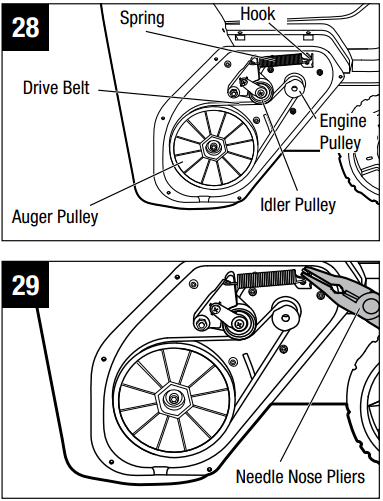
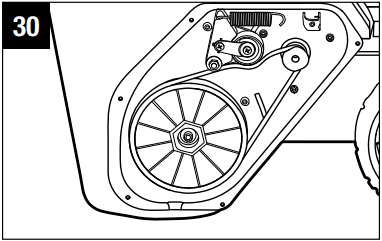
Tips: Rotate the new drive belt first around the engine pulley, then the idle pulley, and finally around the auger pulley. Slowly turn the auger pulley clockwise to drive the belt inwards (Fig. 28).
5. Use needle nose pliers to install the spring onto the hook to tension the drive belt (Fig. 29).
6. Reinstall the drive belt cover with the 8 Torx screws removed in step 1 (Fig. 27).

STORING THE SNOW BLOWER
CAUTION: Ensure that all melted snow that may drip from the snow blower is properly wiped up to prevent a slip and fall hazard.
- Remove the battery pack(s) and store in a secure location out of the reach of children.
NOTE: When not in use, a 56V battery should be stored in an enclosed area where the temperature will not drop below -4°F (-20°C). Optimal charging temperatures are 41°F - 104°F (5°C - 40°C).
Before storage, wipe any moisture, dirt, or debris from the battery area.
- Wipe the snow blower with a clean dry cloth.
- Check all nuts, bolts, knobs, screws, etc., for tightness.
- Inspect moving parts for damage, breakage, and wear. Have repairs made on any damaged or missing parts.
- Fold the side rails to the storage position.
- Store the snow blower in a clean, dry, enclosed place out of the reach of children.
- Do not store near corrosive materials such as fertilizer or rock salt.
TROUBLESHOOTING
WARNING: Always remove the battery pack(s) when servicing or transporting the snow blower. Always protect your hands by wearing gloves when performing any maintenance on the snow blower auger or scraper.
| PROBLEM | CAUSE | SOLUTION |
| Side rails are not in position. | ◾ Knobs on the side rails and/or handle-clamp lever are not secured. | ◾ Make sure that knobs on the side rails are fully tightened and the handle-clamp levers are fully closed. |
| Snow blower is not starting. | ◾Battery charge is low. | ◾Charge the battery. |
| ◾The steel auger is frozen by snow or ice. | ◾ Remove the battery pack(s) firstly, use the a clean-out tool to clear the snow or ice that obstruct on the auger. Restart the snow blower. | |
| ◾ The battery is overteated. The LED indicator on the battery flashes orange or shines red. (see the section “BATTERY HIGH-TEMPERATURE PROTECTION” in this manual. | ◾ Remove the overheated battery from the snow blower and wait until the battery pack cools down to approximately 152°F (67°C), then reinstall the battery and restart the snow blower. | |
| ◾ Safety Button is not depressed. | Press the safety button and, with the button depressed, pull the bail switch upward to meet the handle. | |
| The motor is on but the auger does not turn. | ◾ The drive belt is worn or broken. | ◾ Replace the drive belt following the section “REPLACING THE DRIVE BELT” in this manual. |
| After passing, the snow blower leaves a layer of snow on the ground. | ◾ The scraper bar is worn. | ◾ Replace the scraper following the section “REPLACING THE SCRAPER BAR” in this manual. |
See other models: SNT2102 SNT2100
